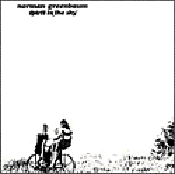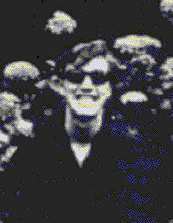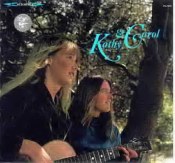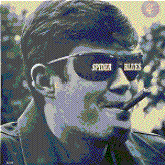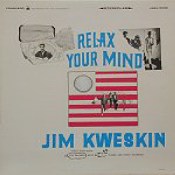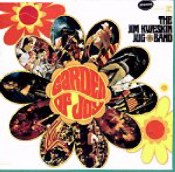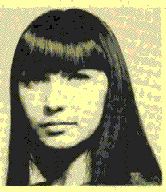|
|
Greenbaum, Norman : In 1965 or '66, he formed Dr. West's Medicine Show and Junk Band, recording one album and a semi-hit single (The Eggplant that ate Chicago), and popping up in 1969 as Norman Greenbaum. He released a big hit (Spirit in the sky) that year which was followed over the next 4 years by two more albums on Reprise. Greenbaum went into flower cultivation and occasionally emerges now and then with proclamations of general satisfaction with life.
|
|
|
 Greene, Richard - Virtuoso Fiddler from California's green and fertile imaginary bluegrass hills and dales, he first played with numerous local old timey and bluegrass bands while a student at Berkeley . After graduation, he veered slightly in his intent to become a real estate salesman and went instead in 1964 to NYC where he met up with Bill Keith (who was playing with Bill Monroe at the time), recorded (uncredited) with the Greenbriar Boys and by 1966 had himself been hired by Monroe. A short stint in the Bluegrass Boys was followed in 1967 by his employment in the Kweskin Jug Band (recording only one LP with them, Garden of Joy ), he left when the band was folded, and at Andy Kulberg's request, he stepped into the remains of the Blues Project, which Greene then suggested needed the addition of old buddy Peter Rowan, and became Seatrain (recording three albums with them). At some point in here, he also had time to write the score for the movie Riverrun. With Tim Weissberg, Jim Rooney and Bill Keith, he then formed influential Blue Velvet Band for the duration of one LP, after which he spent most of the remaining decade as a backing musician for a wide array of performers, from EmmyLou Harris and Taj Mahal to Rod Stewart and Loggins & Messina. During this time he also performed and recorded with David Grisman and Jerry Garcia as Old & In the Way which later mutated into Muleskinner (with Clarence White replacing Garcia, and in 1974, he joined Grisman and Taj Mahal in forming the folk-bluegrass ensemble called the great American Music Band. Not one to waste a spare moment, he also recorded three solo albums with his band The Zone,in the late 70s for Rounder, plus another for Sierra, then toured Japan with Tony Trischka & Peter Rowan (releasing two Japan-only albums in 1980). Since then, he's performed all over, with everyone, done recordings with half the known world, won a Grammy ( in 1997 for his contribution to a Monroe tribute CD on Sugar Hill), gotten another Grammy nomination (1998 - Sales Tax Toddle), and seems to be currently recording for Rebel Records. I will assume idle moments are not high on his list of indulgenses. Greene, Richard - Virtuoso Fiddler from California's green and fertile imaginary bluegrass hills and dales, he first played with numerous local old timey and bluegrass bands while a student at Berkeley . After graduation, he veered slightly in his intent to become a real estate salesman and went instead in 1964 to NYC where he met up with Bill Keith (who was playing with Bill Monroe at the time), recorded (uncredited) with the Greenbriar Boys and by 1966 had himself been hired by Monroe. A short stint in the Bluegrass Boys was followed in 1967 by his employment in the Kweskin Jug Band (recording only one LP with them, Garden of Joy ), he left when the band was folded, and at Andy Kulberg's request, he stepped into the remains of the Blues Project, which Greene then suggested needed the addition of old buddy Peter Rowan, and became Seatrain (recording three albums with them). At some point in here, he also had time to write the score for the movie Riverrun. With Tim Weissberg, Jim Rooney and Bill Keith, he then formed influential Blue Velvet Band for the duration of one LP, after which he spent most of the remaining decade as a backing musician for a wide array of performers, from EmmyLou Harris and Taj Mahal to Rod Stewart and Loggins & Messina. During this time he also performed and recorded with David Grisman and Jerry Garcia as Old & In the Way which later mutated into Muleskinner (with Clarence White replacing Garcia, and in 1974, he joined Grisman and Taj Mahal in forming the folk-bluegrass ensemble called the great American Music Band. Not one to waste a spare moment, he also recorded three solo albums with his band The Zone,in the late 70s for Rounder, plus another for Sierra, then toured Japan with Tony Trischka & Peter Rowan (releasing two Japan-only albums in 1980). Since then, he's performed all over, with everyone, done recordings with half the known world, won a Grammy ( in 1997 for his contribution to a Monroe tribute CD on Sugar Hill), gotten another Grammy nomination (1998 - Sales Tax Toddle), and seems to be currently recording for Rebel Records. I will assume idle moments are not high on his list of indulgenses.
|
 |
 |
|
|
Kathy & Carol - Carol McComb and Kathy Larisch, 20 year-olds from Vista, CA; they sang traditional songs (and one contemporary song, Mark Spoelstra's "Just a hand to hold", which, according to their liner notes, "We sing because it is beautiful") in a very beautiful and haunting high-pitched and vibrato-heavy way, somewhat similar later to the McGarrigle Sisters. Paul Rothchild described their one and only Elektra album (1965) as "The most beautiful Renaissance ballad record I ever heard". They performed 5th at the Newport New Folks concert in 1965 (most notably Fariña's "A Swallow Song"). Carol McComb has looked in and updated me via email, noting that between 1969 and 1971, she perfomed as a duo with Mimi, performing coast-to-coast, including a performance at Carnegie Hall. From 1975-1980, fronted a band called Moonstone, releasing one album; from 1981-89 she fronted a band named the Gryphon Quintet, releasing 3 albums; there followed two solo albums (1990 & 2000), and currently she's gigging around with Keith Little "in a roots-oriented band. Kathy Larisch is an art teacher in Berkley, CA".
( Special notice to photographer James Frawley and cover designer William S. Harvey for their work on this one - you won't find a better cover on any Electra LP of the period - arguably)
|
 |
 Keith, Bill - aka: Brad Keith - Another Boston-born scholar, he originally played dixieland in a group named The Merry Morticians, and later went to Cambridge to study at the Harvard Business School but got sidetracked by the siren song of bluegrass music. Learning banjo from Pete Seeger's instruction manual, Keith became fascinated with Earl Scruggs' technique, and in order to understand what was going on there, he invented a way to transcribe the banjo solos (using the 1957 Faltt & Scruggs lp, Foggy Mountain Jamboree), according to the Richard Smith bio of Bill Monroe, " into standard music notation... then he created tablature to sort out the correct fingering patterns...", shortly thereafter, figuring out a way to translate a number of old fiddle tunes for banjo, and therby creating an entirely new way of playing banjo, allowing players to play far more notes by using chords at differing spots on the neck, which I cannot explain muchless comprehend. he joined forces with guitarist Jim Rooney in 1959, performing mainly in the Boston area, and leaving in 1962 to join a local D.C.-based bluegrass outfit. This didn't last long, as Keith met up with Earl Scruggs, who was impressed by his transcrition of Scrugg's solos, and took him in in early 1963. Keith was almost immediately recruited by Bill Monroe, still in the thick of his life-long commitment to one-up Scruggs for leaving his band. Monroe also apparently immediately forgot, hired someone else, then promptly remembered and hired Keith anyway, moving just-hired and keenly disapointed banjoist Del McCoury over to vocals. According to von Schmidt/Rooney, Monroe promptly renamed Bill Keith as Brad Keith, "because there's just one Bill in Bill Monroe's band" . I think the story is that Bill/Ben got homesick/tired of it all, and moved back to Boston, eventually replacing Mel Lyman on banjo in the Kweskin Jug Band when Lyman left in July of 1965. He stayed with the Jug Band until it disbanded in 1967. He appeared everywhere and with everyone after that, and for the next 30 years, recording with von Schmidt, David Grisman, and practically everyone else who played acoustic music and had a vowel in their name, as well as doing solo albums for Rounder Records. Keith, Bill - aka: Brad Keith - Another Boston-born scholar, he originally played dixieland in a group named The Merry Morticians, and later went to Cambridge to study at the Harvard Business School but got sidetracked by the siren song of bluegrass music. Learning banjo from Pete Seeger's instruction manual, Keith became fascinated with Earl Scruggs' technique, and in order to understand what was going on there, he invented a way to transcribe the banjo solos (using the 1957 Faltt & Scruggs lp, Foggy Mountain Jamboree), according to the Richard Smith bio of Bill Monroe, " into standard music notation... then he created tablature to sort out the correct fingering patterns...", shortly thereafter, figuring out a way to translate a number of old fiddle tunes for banjo, and therby creating an entirely new way of playing banjo, allowing players to play far more notes by using chords at differing spots on the neck, which I cannot explain muchless comprehend. he joined forces with guitarist Jim Rooney in 1959, performing mainly in the Boston area, and leaving in 1962 to join a local D.C.-based bluegrass outfit. This didn't last long, as Keith met up with Earl Scruggs, who was impressed by his transcrition of Scrugg's solos, and took him in in early 1963. Keith was almost immediately recruited by Bill Monroe, still in the thick of his life-long commitment to one-up Scruggs for leaving his band. Monroe also apparently immediately forgot, hired someone else, then promptly remembered and hired Keith anyway, moving just-hired and keenly disapointed banjoist Del McCoury over to vocals. According to von Schmidt/Rooney, Monroe promptly renamed Bill Keith as Brad Keith, "because there's just one Bill in Bill Monroe's band" . I think the story is that Bill/Ben got homesick/tired of it all, and moved back to Boston, eventually replacing Mel Lyman on banjo in the Kweskin Jug Band when Lyman left in July of 1965. He stayed with the Jug Band until it disbanded in 1967. He appeared everywhere and with everyone after that, and for the next 30 years, recording with von Schmidt, David Grisman, and practically everyone else who played acoustic music and had a vowel in their name, as well as doing solo albums for Rounder Records.
|
|
|
Koerner, Spider John - Blues singer and 7-string guitar-player from Minneapolis, occasional part of Koerner, Ray and Glover (with Tony Glover and Dave Ray), film fan, and hilarious surreal raconteur. He performed three times at the '65 Newport Festival, including second at the New Folks concert on Sunday (with Dave Ray on harmonica). In addition to three Koerner, Ray & Glover albums, he released his own solo album on Elektra (Spider Blues) in 1965, then after a quiet period, released Running, Jumping, Standing Still (named after the Richard Lester short film) in 1969 on Elektra; done in conjunction with fellow Minneapolitan Willie Murphy and the Bumblebees, promoted by the label (who even issued a promo-only 45 interview with Koerner & Murphy), it never had huge sales, but has had a solid reputation over the years. And in my humble opinion, if you only own three records/CDs, this should be one of them (and find the single [ Elektra, EKM-45654] of "Friends & Lovers" c/w "Magazine Lady" , since both are different takes). Koerner went on to issue the follow-up album (again with Willie & the Bumblebees), Music Is just a Bunch of Notes as a homemade project, each album jacket hand-stamped, colored with magic-markers, sealed with masking taped and sold for $2.00 on Sweet Jane Records. He later started his own label, Red House Records, releasing records including his own as well as reissuing the K,R & G albums in their original configurations.
|
|
|
 Kweskin, Jim - (see also Kweskin Jug Band) Originally a jazz fiend from Stanford, Conn., he moved to Cambridge, MA, picked up guitar from Eric von Schmidt and began gigging at Club 47. One of the great 78 collectors of this period, he made numerous song-collecting trips throughout the U.S., finding other collectors and taping hundreds of old 78s. He played an eclectic mix of old timey, jug band, ragtime, and straight jazz tunes and contributed heavily to the revival and populariuzation of this music when he formed the Jug Band in 1963 from carefully selected local musicians. The Jug Band broke up in 1968 after concerts turned into verbal confrontations between Kweskin and the audience over his devotion to Mel Lyman. Kweskin settled into the Beacon Hill area of Boston, began a very short run as head of The Avatar, an underground paper devoted to Lyman, began buying up considerable amounts of real estate in Beacon Hill (then practically, if not literally, a slum) did two LPs with the Lyman Family for Reprise (the first being scheduled as a Lisa Kindred session backed by Muldaur, Kweskin, and Lyman plus various members of the Lyman Family - Kindred was rumored to be greatly surprized when it was released as the Lyman Family) then sat it out for several years (necessitated , according to von Schmidt, by having been badly beaned by a brick during a dope deal), he returned in the late 70s to record several albums for Mountain Railway, including a childrens' album. He pops up now and then. Kweskin, Jim - (see also Kweskin Jug Band) Originally a jazz fiend from Stanford, Conn., he moved to Cambridge, MA, picked up guitar from Eric von Schmidt and began gigging at Club 47. One of the great 78 collectors of this period, he made numerous song-collecting trips throughout the U.S., finding other collectors and taping hundreds of old 78s. He played an eclectic mix of old timey, jug band, ragtime, and straight jazz tunes and contributed heavily to the revival and populariuzation of this music when he formed the Jug Band in 1963 from carefully selected local musicians. The Jug Band broke up in 1968 after concerts turned into verbal confrontations between Kweskin and the audience over his devotion to Mel Lyman. Kweskin settled into the Beacon Hill area of Boston, began a very short run as head of The Avatar, an underground paper devoted to Lyman, began buying up considerable amounts of real estate in Beacon Hill (then practically, if not literally, a slum) did two LPs with the Lyman Family for Reprise (the first being scheduled as a Lisa Kindred session backed by Muldaur, Kweskin, and Lyman plus various members of the Lyman Family - Kindred was rumored to be greatly surprized when it was released as the Lyman Family) then sat it out for several years (necessitated , according to von Schmidt, by having been badly beaned by a brick during a dope deal), he returned in the late 70s to record several albums for Mountain Railway, including a childrens' album. He pops up now and then.
|
|
|
 Kweskin Jug Band - First organized around jam sessions at Club 47 headed by solo performer Jim Kweskin and attended by ambitious/fascinated/dazzled Cambridge, MA performers all hoping to swipe/borrow/learn songs from his encyclopedic mind. Forming a permanent group became a distinct possibility when Kweskin performed with blues singer/guitarist Geoff Muldaur (despite, according to von Schmidt & Rooney's book, Baby, Let Me Follow You Down, Kweskin's first impression of him as " straight, uptight and surly", but also finding him tremendously sympatico musically) in February, 1963 at the Community Church in Boston. Shortly thereafter, Vanguard records head Maynard Soloman offered Kweskin and his current group a contract, which Kweskin declined, suggesting instead that Soloman give him three months to come up with an ideal band, which Soloman agreed do. The line up was then fixed on David Simon (aka Bruno Wolf and about 15 other names) on vocals, kazoo and harmonica, Fritz Richmond (the house bass player at Club 47) on jug and washtub bass, Geoff Muldaur on washboard, guitar and vocals, Bob Siggins on banjo (a Charles River Valley Boys permanent member who agreed to join only long enough to record), and Kweskin on guitar. This configuration of the band recorded an LP for Vanguard which was released in October of '63. Local musician Mel Lyman replaced Siggins on banjo (and later David Simon on harmonica), and Maria Muldaur (orignally D'Amato - vocals, fiddle) was added to the group on their second album (April, '65). Lyman left after a memorable weekend at the 1965 Newport Festival when Maria Muldaur unknowingly cut off his lengthy harmonica solo during one number. He was replaced by Bill Keith ( another New Englander and virtuoso banjoist who'd already played as a duet with Jim Rooney, then with Bill Monroe by that point) on their 3rd Lp (See Reverse Side For Title, released 12/66). After Newport, the Jug Band joined the rest of the world by going electric, but rather than shifting over to electric instruments, they went the fun route, attaching pick-ups and contact mikes to their instruments, all the way down to the kazoo (reviewed, following an appearance at the Main Point in Bryn Mawr, PA, as the "totally electric Jim Kweskin Jug Band" By the third album, Richard Greene (veteran of the Greenbriar Boys and Bill Monroe) had replaced Maria Muldaur's fiddle work (Maria would continue on vocals and percussion), and this version of the band made a second appearnce at Newport in 1966, awash in a light show. The Band started falling apart as Kweskin's devotion grew to what he saw as Mel Lyman's divinity, but a fourth album and a single were released by the band on Reprise in 1967. According to reports, Muldaur & Co., enjoying the group's musical level and with every confidence in the group's ability to continue without Kweskin made a plea to continue as The Jug Band, but this idea was nixed by Kweskin and the group sadly went their separate ways. The Kweskin-less Jug Band (but with both Muldaurs and Fritz Richmond) did appear at the Philadelphia Folk Festival in the early 80s, though any other appearances are unknown. Doggone it. Kweskin Jug Band - First organized around jam sessions at Club 47 headed by solo performer Jim Kweskin and attended by ambitious/fascinated/dazzled Cambridge, MA performers all hoping to swipe/borrow/learn songs from his encyclopedic mind. Forming a permanent group became a distinct possibility when Kweskin performed with blues singer/guitarist Geoff Muldaur (despite, according to von Schmidt & Rooney's book, Baby, Let Me Follow You Down, Kweskin's first impression of him as " straight, uptight and surly", but also finding him tremendously sympatico musically) in February, 1963 at the Community Church in Boston. Shortly thereafter, Vanguard records head Maynard Soloman offered Kweskin and his current group a contract, which Kweskin declined, suggesting instead that Soloman give him three months to come up with an ideal band, which Soloman agreed do. The line up was then fixed on David Simon (aka Bruno Wolf and about 15 other names) on vocals, kazoo and harmonica, Fritz Richmond (the house bass player at Club 47) on jug and washtub bass, Geoff Muldaur on washboard, guitar and vocals, Bob Siggins on banjo (a Charles River Valley Boys permanent member who agreed to join only long enough to record), and Kweskin on guitar. This configuration of the band recorded an LP for Vanguard which was released in October of '63. Local musician Mel Lyman replaced Siggins on banjo (and later David Simon on harmonica), and Maria Muldaur (orignally D'Amato - vocals, fiddle) was added to the group on their second album (April, '65). Lyman left after a memorable weekend at the 1965 Newport Festival when Maria Muldaur unknowingly cut off his lengthy harmonica solo during one number. He was replaced by Bill Keith ( another New Englander and virtuoso banjoist who'd already played as a duet with Jim Rooney, then with Bill Monroe by that point) on their 3rd Lp (See Reverse Side For Title, released 12/66). After Newport, the Jug Band joined the rest of the world by going electric, but rather than shifting over to electric instruments, they went the fun route, attaching pick-ups and contact mikes to their instruments, all the way down to the kazoo (reviewed, following an appearance at the Main Point in Bryn Mawr, PA, as the "totally electric Jim Kweskin Jug Band" By the third album, Richard Greene (veteran of the Greenbriar Boys and Bill Monroe) had replaced Maria Muldaur's fiddle work (Maria would continue on vocals and percussion), and this version of the band made a second appearnce at Newport in 1966, awash in a light show. The Band started falling apart as Kweskin's devotion grew to what he saw as Mel Lyman's divinity, but a fourth album and a single were released by the band on Reprise in 1967. According to reports, Muldaur & Co., enjoying the group's musical level and with every confidence in the group's ability to continue without Kweskin made a plea to continue as The Jug Band, but this idea was nixed by Kweskin and the group sadly went their separate ways. The Kweskin-less Jug Band (but with both Muldaurs and Fritz Richmond) did appear at the Philadelphia Folk Festival in the early 80s, though any other appearances are unknown. Doggone it.
|
|
|
Leonda - Not at all well-known blues-oriented folk singer, she was wonderful to see perform. An audience could go blind when she smiled. The Philadelphia Folk Festival program for 1967 (from whence comes the photo), described her as " half Cherokee and half-English, her repetoire is as diverse as her background, ranging from ballads to blues to comic to gospel". She also represented the US at the Festival of light Music at Sopot in Poland in the summer of 1967. She had an album out in 1968 on Epic (BN-26383), and should have had more.
Leonda was the opening act for the Fariñas at the Main Point, in Bryn Mawr, PA, the snowy weekend they played there in Feb.'66.
|
 |
Lightfoot, Gordon - Canadian singer-songwriter, who made his American festival debut at the Newport Folk Festival in 1965, performing with the Fariñas and Dylan at the Contemporary Song Workshop on Saturday, and again with the Fariñas on Sunday at the New Folks concert, going on right before them. His first album came out a year later, curiously enough, on United Artists (name another folk artist on United Artists - besides the Highwaymen -). Managed by Albert Grossman and produced by Grossman's assistant, John Court, Lightfoot authored such classics as "For lovin; me", "Early mornin' rain" , and "Did she mention my name" before moving on to Reprise in 1970 and issuing Sit Down Young Stranger, which was quickly reissued as If You Could Read My Mind when that song took over the airwaves, as did its author for a large chunk of the 70s singer/songwriter revival.
|
